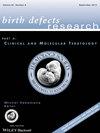Catherine S. Gibson, Heather Scott, Eric Haan, Wendy Scheil
下载PDF
{"title":"纳入的年龄范围影响出生缺陷登记的确定","authors":"Catherine S. Gibson, Heather Scott, Eric Haan, Wendy Scheil","doi":"10.1002/bdra.23534","DOIUrl":null,"url":null,"abstract":"<div>\n \n <section>\n \n <h3> Background</h3>\n \n <p>The South Australian Birth Defects Register (SABDR) has collected the date of diagnosis of notified birth defects since the 2005 birth year cohort. This study aims to document the age at diagnosis for each of the main diagnostic categories of birth defects, to produce a profile of when defects are diagnosed.</p>\n </section>\n \n <section>\n \n <h3> Methods</h3>\n \n <p>Deidentified data were extracted from the SABDR for birth years 2005 to 2007. Each birth defect was assigned to a mutually exclusive date of diagnosis category (termination/stillbirth; neonatal [birth–28 days]; 1 month–1 year; 1–2 years; 2–3 years; 3–4 years; 4–5 years; unspecified). Each defect was also grouped according to the International Classification of Diseases Ninth edition–British Paediatric Association major diagnostic categories (nervous, cardiovascular, respiratory, gastrointestinal, urogenital, musculoskeletal, chromosomal, metabolic, hematological/immune, other).</p>\n </section>\n \n <section>\n \n <h3> Results</h3>\n \n <p>There were 6419 defects identified in 3676 individuals, and 98.6% of defects had a diagnosis date recorded. Terminations of pregnancy/stillbirths accounted for 20.3% of defects notified, and a further 46.7% of defects were diagnosed within the neonatal period. A total of 81.5% of defects were diagnosed by 1 year of age. An additional 17.2% of defects were diagnosed between the ages of 1 and 5 years. There were wide differences in age at diagnosis between the major diagnostic categories.</p>\n </section>\n \n <section>\n \n <h3> Conclusion</h3>\n \n <p>This study highlights the value of birth defect registers collecting information about birth defects from terminations of pregnancy, stillbirths, and live births up to a child's fifth birthday. Reviewing diagnosis date provides insight into the pattern of diagnosis of different birth defects. This provides valuable information to medical specialists and researchers regarding the interpretation of information from birth defect data collections. Birth Defects Research (Part A) 106:761–766, 2016. © 2016 Wiley Periodicals, Inc.</p>\n </section>\n </div>","PeriodicalId":8983,"journal":{"name":"Birth defects research. Part A, Clinical and molecular teratology","volume":"106 9","pages":"761-766"},"PeriodicalIF":0.0000,"publicationDate":"2016-06-21","publicationTypes":"Journal Article","fieldsOfStudy":null,"isOpenAccess":false,"openAccessPdf":"https://sci-hub-pdf.com/10.1002/bdra.23534","citationCount":"5","resultStr":"{\"title\":\"Age range for inclusion affects ascertainment by birth defects registers\",\"authors\":\"Catherine S. Gibson, Heather Scott, Eric Haan, Wendy Scheil\",\"doi\":\"10.1002/bdra.23534\",\"DOIUrl\":null,\"url\":null,\"abstract\":\"<div>\\n \\n <section>\\n \\n <h3> Background</h3>\\n \\n <p>The South Australian Birth Defects Register (SABDR) has collected the date of diagnosis of notified birth defects since the 2005 birth year cohort. This study aims to document the age at diagnosis for each of the main diagnostic categories of birth defects, to produce a profile of when defects are diagnosed.</p>\\n </section>\\n \\n <section>\\n \\n <h3> Methods</h3>\\n \\n <p>Deidentified data were extracted from the SABDR for birth years 2005 to 2007. Each birth defect was assigned to a mutually exclusive date of diagnosis category (termination/stillbirth; neonatal [birth–28 days]; 1 month–1 year; 1–2 years; 2–3 years; 3–4 years; 4–5 years; unspecified). Each defect was also grouped according to the International Classification of Diseases Ninth edition–British Paediatric Association major diagnostic categories (nervous, cardiovascular, respiratory, gastrointestinal, urogenital, musculoskeletal, chromosomal, metabolic, hematological/immune, other).</p>\\n </section>\\n \\n <section>\\n \\n <h3> Results</h3>\\n \\n <p>There were 6419 defects identified in 3676 individuals, and 98.6% of defects had a diagnosis date recorded. Terminations of pregnancy/stillbirths accounted for 20.3% of defects notified, and a further 46.7% of defects were diagnosed within the neonatal period. A total of 81.5% of defects were diagnosed by 1 year of age. An additional 17.2% of defects were diagnosed between the ages of 1 and 5 years. There were wide differences in age at diagnosis between the major diagnostic categories.</p>\\n </section>\\n \\n <section>\\n \\n <h3> Conclusion</h3>\\n \\n <p>This study highlights the value of birth defect registers collecting information about birth defects from terminations of pregnancy, stillbirths, and live births up to a child's fifth birthday. Reviewing diagnosis date provides insight into the pattern of diagnosis of different birth defects. This provides valuable information to medical specialists and researchers regarding the interpretation of information from birth defect data collections. Birth Defects Research (Part A) 106:761–766, 2016. © 2016 Wiley Periodicals, Inc.</p>\\n </section>\\n </div>\",\"PeriodicalId\":8983,\"journal\":{\"name\":\"Birth defects research. Part A, Clinical and molecular teratology\",\"volume\":\"106 9\",\"pages\":\"761-766\"},\"PeriodicalIF\":0.0000,\"publicationDate\":\"2016-06-21\",\"publicationTypes\":\"Journal Article\",\"fieldsOfStudy\":null,\"isOpenAccess\":false,\"openAccessPdf\":\"https://sci-hub-pdf.com/10.1002/bdra.23534\",\"citationCount\":\"5\",\"resultStr\":null,\"platform\":\"Semanticscholar\",\"paperid\":null,\"PeriodicalName\":\"Birth defects research. Part A, Clinical and molecular teratology\",\"FirstCategoryId\":\"1085\",\"ListUrlMain\":\"https://onlinelibrary.wiley.com/doi/10.1002/bdra.23534\",\"RegionNum\":0,\"RegionCategory\":null,\"ArticlePicture\":[],\"TitleCN\":null,\"AbstractTextCN\":null,\"PMCID\":null,\"EPubDate\":\"\",\"PubModel\":\"\",\"JCR\":\"Q\",\"JCRName\":\"Medicine\",\"Score\":null,\"Total\":0}","platform":"Semanticscholar","paperid":null,"PeriodicalName":"Birth defects research. Part A, Clinical and molecular teratology","FirstCategoryId":"1085","ListUrlMain":"https://onlinelibrary.wiley.com/doi/10.1002/bdra.23534","RegionNum":0,"RegionCategory":null,"ArticlePicture":[],"TitleCN":null,"AbstractTextCN":null,"PMCID":null,"EPubDate":"","PubModel":"","JCR":"Q","JCRName":"Medicine","Score":null,"Total":0}
引用次数: 5
引用
批量引用

 求助内容:
求助内容: 应助结果提醒方式:
应助结果提醒方式:


